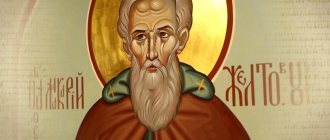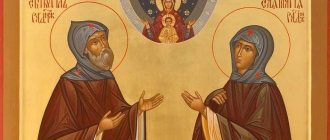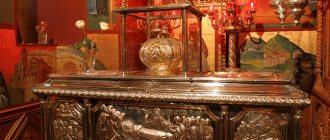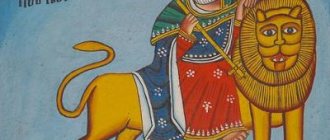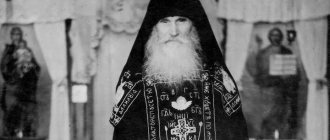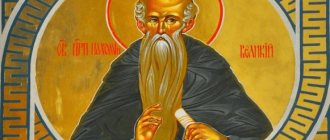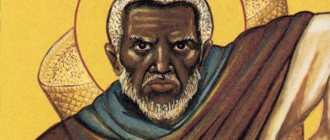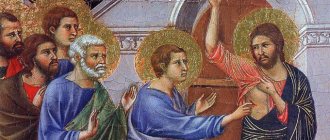Nikita Besogon
Wikipedia has articles about other people named Nikita.
Saint Nikita beating the demon. Icon of the first half of the 16th century. State Tretyakov Gallery
great martyrs
September 15 (28)
He beats the demon-devil who tempted him to embrace paganism. Usually depicted as holding the demon with his left hand, and striking it with his shackles in his right hand, which is raised in a swing.
martyrdom
Category on Wikimedia Commons
Nikita Besogon - early Christian saint, apocryphal great martyr, who was tortured and accepted death for Christ in Constantinople; son of the Roman Emperor Maximian. Widely known in Christian iconography in the motif of his beating of the demon-devil, who tempted him to embrace paganism.
On September 15 (28) there was a commemoration of two holy great martyrs named Nikita - Besogon and Gotfsky. During the time of Peter I, the apocrypha about the life of Nikita, the son of Maximian, was rejected, but not because another life was recognized as true, but because of less popularity. Only Nikita Gotfsky was read on this day. Subsequently, in iconography, stories about them sometimes merged, although Nikita Gotfsky did not “physically” fight with the demon.
Description and role in Orthodoxy
One of the most famous prayers in the Orthodox faith is the Our Father. It is believed that Jesus Christ himself left it to people. The Savior spoke the Galilean dialect of Aramaic. But the original sacred text has not survived to this day. Therefore, it is impossible to establish whether the prayer service was actually written in this dialect.
The prayer text appeared in the early times of the formation of the Christian faith in the world. The oldest version of this prayer that has survived to this day is written in the ancient Koine Greek dialect. There are several texts of this petition.
In the Gospel, the Lord's Prayer is written in two versions. The extended version is given in the Gospel of Matthew, and the summary is given in the Gospel of Luke.
There is no clear opinion about the circumstances of the prayer service. The prayer in the Gospel of Matthew is given as part of the Sermon on the Mount. Luke says that Christ gave it to his disciples when they asked him to “teach them to pray.”
The version given in Matthew is considered universal. It is this that is most common in the Christian world. This option is reproduced in the Didache, an ancient Christian writing of a catechetical nature, dating from the end of the 1st - beginning of the 2nd century. It also says that prayers must be said three times a day.
Later, other versions of this prayer appeared. The reason for their writing is the author’s desire to emphasize certain points of ambiguous concepts given in the text.
Due to the fact that the Savior himself gave the Holy Scriptures to people, the prayer service is deeply revered by Christians around the world. The prayer reflects the ardent desire of believers to glorify the Lord and the happiness that they will experience with the coming of God's Kingdom to earth.
Regardless of the text, “Our Father” consists of three parts:
- in the first the name of the Lord is glorified;
- in the second part a request is made to God;
- end of prayer.
In the petition, the request is made to the Lord seven times. This prayer service is read in difficult times for a person. With its help, people ask higher powers for health, help in finding work for family well-being, and forgiveness of sins. A petition made from a pure heart will allow a person to resist the temptations of the world.
The prayer service helps you calm down, accept your grievances and forgive your offenders. Like any petition, “Our Father” is able to relieve mental pain, allows you to see the right decision, and sometimes heal. Moreover, healing occurs both of the physical body and of the soul.
Before reading this prayer, you must concentrate. It is best to go to a separate room, if possible. You can pray both in front of the icon of the Lord and without it.
Before you start reading, you need to kneel down and close your eyes. After this, the person needs to cross himself. Next, the beginning of the prayer is said.
It is best to read the text without peeking. The Lord's Prayer is easy to remember. Therefore, almost all believers know this petition by heart. There is no need to rush while reading. All words should be pronounced clearly, with a deep understanding of the spoken words.
If you read a prayer with faith, the Lord will definitely hear it and help the one who asks.
Life
The life of the martyr Nikita goes back to the New Testament apocrypha “The Tale of Nikita’s Torment.” According to researchers, it is a reworking of the text of the life of one of the early Christian martyrs named Nikita, who was celebrated on the same day as Nikita of Gotf. Mention of it is found in the index of renounced books of the 11th century; it was included in the “Rule 59 of the Council of Laodicea” along with the “Apostolic Acts”, “The Torment of St. George” and other so-called Bogomil apocrypha. The early existence of apocryphal life in Rus' is known from literary monuments, in particular from the “Tale of Boris and Gleb” of the mid-11th century, which mentions that in his dying prayer, Saint Prince Boris recalled the suffering and torment of Saints Nikita, Vyacheslav and Varvara, who died from the hands of their relatives. According to N. S. Tikhonravov and V. M. Istrin, the translation was made in Southern Rus' by the 12th century. The Life is known in several copies in Greek and Slavic languages, which date back to the 12th-13th centuries.
In Russian lists of renounced books, the life is called “Nikitino’s torment, naming his son Maximyanov Tsarev.” The surviving lists date back to the end of the 15th century.
The martyr Nikita was popularly called “besogon.” In the popular imagination of the Eastern Slavs, the apocryphal image of the religious legend about Nikita merges with folk legends about Nikita Kozhemyak, the hero who defeated the evil dragon.
There are also ancient temples in honor of St. Nikita. In Pereslavl-Zalessky, presumably already in the 12th century there was a Nikitsky monastery. A temple was also built at the Plotnitsky end of Novgorod, first mentioned in the chronicle in 1368.
Plot
According to the plot of the apocrypha, Nikita was the son of the pagan king Maximian, who, together with his co-ruler Emperor Diocletian, was known for the great persecution of Christians, in particular for the torment of the holy great martyrs George and Panteleimon. It should be noted that the real Roman Emperor Maximian did not have a son, Nikita, and his only son was not known for martyrdom for Christianity.
Once Nikita tried to convert his father to the Christian faith, but he refused and he himself tried to convert Nikita to paganism. In response, Nikita asked for 12 golden idols in order to secretly worship them; the king, overjoyed, gave them, but Nikita miraculously ground them into powder. Seeing the remains of the destroyed idols, the ruler cried out that it was not Saint George who taught him to do this? To which Nikita responded negatively, adding that he “trusts in God.” Maximian also mentioned that George was “tortured by Dadian,” whom Maximian calls his “brother,” here presumably referring to Emperor Diocletian.
The destruction of the idols angered the king so much that he tried several ways to kill his son Nikita, but miracles happened and the executions failed. Then the king threw Nikita into prison. There a demon appeared to Nikita in the guise of an angel and began to tempt him to renounce Christianity. Hearing the voice of the devil, Nikita prayed to see the tempter, then the Archangel Michael appeared to him, telling him to reach out and grab the demon. Nikita grabbed the demon and, throwing him down, stepped on his neck. And then he took the shackles off his feet and began to beat the devil, who called himself Beelzebub, with them.
Nikita spent 3 years in prison. Then the king remembered him and ordered him to be brought. Nikita brought the demon with him and cast him down before the king, showing who controlled him. However, the king was inexorable and again ordered his son to be executed as a martyr, but again a miracle happened and the executions failed. Also, Nikita, with the help of the newly appeared Archangel Michael, showed the miracle of the resurrection of two people buried in a stone pillar. But the king again did not believe him. Then all the people and the queen rebelled against the king, and Nikita baptized 18,400 people that day.
Iconography
The peak of popularity of images of Nikita on icons, serpentines and crosses occurred in the 16th-17th centuries, during the era of the Stroganov school of icon painting. He was the most famous and revered Nikita by Christians until the schism of the Russian Church in 1666. Old Believers revered him until the 19th century.
The initial image of the exorcist saint changed, gradually approaching the generalized image of the conqueror of paganism (the demon). At the beginning, the illustrations were close to the text of the apocrypha about the martyr Nikita, then they turned into images of the demon fighter, correlated with the saints: Nikita of Gotha, Nikita - the youth of Asia Minor, Nikita of Novgorod, as well as the Archangel Michael and others.
In connection with the renunciation of this apocrypha by the Church and the canonization of another life of the martyr Nikita of Gotha, venerated on the same day, the images of these martyrs are sometimes merged in Russian icon painting.
It was believed that the image of Saint Nikita protected from evil spirits. People turned to him for various family troubles, in particular, when children were damaged and for healing from a “relative”. There are two prayers to the martyr Nikita. Nikita the Besogon, as he was popularly called, was usually depicted with a stick or shackles, beating a demon.
There is a well-known painting of the wall of the Vladimir Demetrius Cathedral (1197), which gained popularity among craftsmen in cast crosses, cast icons and copper vests in the 12th-17th centuries.
For example, the Russian Museum houses a three-row icon of the 15th-16th centuries with the image of Besogon. There is also an icon “Nicetas slaying the demon, with the Deesis and selected saints” of the Novgorod school of icon painting of the last third of the 15th century, kept in a private collection, which differs in the style of painting from that stored in the Russian Museum.
- Niketas slaying the demon, with Deesis and selected saints. Novgorod, last third of the 15th century
- Icon of the first half of the 16th century, Moscow school. State Tretyakov Gallery
- Icon of the late 18th century
- 19th century icon
- Saint Nikita beating the demon. 1843. State Russian Museum
- Bronze icon or cast icon, 19th century
Kontakion, voice 2*
I have cut through the power of grace with your standing, / and received the crown of victory in your suffering, / with the Angels you rejoice more gloriously, / Nikita’s namesake, / with them, praying to Christ God incessantly for all of us.
Translation: You destroyed the reign of error by your opposition and received the crown of victory in your martyrdom, with the angels, glorified, you rejoice, Nikitas of the victory of the same name (Nikitas from the Greek νίκη - victory), with them praying to Christ God incessantly for all of us.
Notes
- 1 2 Istrin, 1898, p. 3-5.
- Dimitry Rostovsky. The Suffering of the Holy Martyr Nikita // Lives of the Saints.
- Saenkova, 2008, p. 168.
- Belik Zh. G., Savchenko O. E. Life cycle of Nikita the Warrior
- 1 2 Rozhdestvenskaya, 1985.
- The Legend of Boris and Gleb (inaccessible link). Electronic library of the Institute of Russian Literature (Pushkin House). Retrieved January 8, 2014. Archived November 3, 2013.
- 1 2 3 Saenkova, 2008, p. 168-169.
- Martyr Nikita, son of Tsar Maximian. spsearch.ru.
- Gnutova S.V., Zotova E.Ya. Crosses, icons, folds: copper artistic casting of the 11th - early 20th centuries - Central Museum of Ancient Russian Culture and Art named after Andrei Rublev Interbook-business, 2000-133 p. — P. 7
- Domashneva N. A. To the secrets of the Basmanny Triangle: essays on cultural history - Russian Chemical-Technological University named after. D. I. Mendeleeva, 2002—112 p. — P. 9
- Saenkova, 2008, p. 169.
- Saenkova, 2008, p. 173-174.
- Khukharev, 1994.
- Holy Martyr Nikita Besogon
- Holy Martyr Nikita Besogon on crosses and icons from Kaluga / V. A. Tkachenko, V. V. Khukharev // Through the centuries...: Materials of the 2nd mountain. local historian conf. / Centralized bib. system of Kaluga. - Kaluga: , 1999. - P. 68-80.
- Antonov, 2010.
- Istrin, 1898, p. 4.
- Saenkova, 2008, p. 168, 171.
- Saenkova, 2008, p. 171-172.
- Okuneva I. N. Icon of St. Nikita beating the demon // Seminarium Kondakovianum. Collection of articles on archeology and Byzantine studies, published by the N. P. Kondakov Institute. - Prague, 1935. - T. VI. - pp. 205-216.
- Kondakov N.P. Russian icon: . - M., 2004. - T. II. - P. 85. - ISBN 5-89709-018-1.
- Chetyrkin I. On the issue of images of the Great Martyr Nikita // Proceedings of the X Archaeological Congress in Riga. - M., 1900. - T. III. — P. 93.
The story of Saint Nikita
One of the first Christians, the Great Martyr Nikita, according to legend, was born into the family of the pagan Tsar Maximian, who was particularly cruel in dealing with the first Christian communities. Nikita more than once turned to his father with a request to convert to Christianity, but he, in a rage, tried to kill his son, and when this failed, he imprisoned him. In prison, a demon appeared to the future great martyr, albeit in the guise of an angel, and began to persuade the young man to renounce his chosen faith. Nikita began to pray to the Lord, and soon the Archangel Michael appeared to him, commanding him to test the devil. The young man grabbed the false guest, and, stepping on his neck, beat him with his own shackles.
The future great martyr spent three years in prison, and when the king called his son to repentance, the young man brought with him a defeated demon, proving to his father that it was the evil forces that controlled his heart. The king was inexorable and ordered his son to be executed, but God did not allow this. To prove the righteousness of the Christian faith and convert his father to Christianity, Nikita resurrected two people, and a little later, according to legend, baptized more than 18,000 people.
How to read correctly
Prayer can be truly prayer, or it can be a purely external form. And do you know what a tragedy? Almost no one knows how to pray correctly. The Holy Fathers decisively say: “Prayer without attention and emotional attitude to the words is an empty exercise.” And not only empty, but even offensive to God.
Prayer without attention is self-deception. Anyone can simply proofread a text, but without faith it means nothing. Don't engage in such terrible self-deception.
Saint Theophan the Recluse said this: “If you don’t have time or you are very tired and cannot read a prayer, okay, do this: think, you can stand for 5 minutes and pray. (- Yes I can). Set your alarm so that it rings in 5 minutes
During these 5 minutes, read with full attention the prayers you want. Pray this time, and it will turn out to be a thousand times more valuable and useful than you mindlessly jabbering these prayers to the end.”
Prayers to Saint Nikita Besogon
First prayer
O great passion-bearer of Christ and wonder-working Great Martyr Nikito! Falling before your holy and miraculous image, while your deeds and miracles and your many compassion for people are glorifying, we pray to you diligently: show us the humble and sinners your holy and powerful intercession, for it is a sin for our sake, not the imams of the freedom of the children of God, for our needs We boldly ask our Lord and our Master, but we offer you a favorable prayer book for him and we cry for your intercession, ask us from the Lord for beneficial gifts for our souls and bodies, right faith, undoubted hope of salvation, unfeigned love for everyone, courage in temptation, their patience in suffering, constancy in prayer, health of soul and body, fruitfulness of the earth, prosperity of the air, contentment of everyday needs, peaceful and pious life on earth, Christian death and a good answer at the terrible judgment of Christ. Also, O passion-bearer of Christ, from the Heavenly King ask our Russian country for peace, health and salvation, and against our enemies victory and victory, prosperity, silence and prosperity. Be a companion and helper against the enemies of the Christ-loving army, and show your holy intercession to all Orthodox people: heal the sick, comfort the sorrowing, help the needy. Hey, servant of God and long-suffering martyr! Do not forget your holy monastery and all the nuns and worldly people living in it and striving, but hasten to bear the yoke of Christ in humility and patience and graciously deliver them from all troubles and temptations. Bring us all into a quiet haven of salvation and make us worthy to be heirs of the blessed Kingdom of Christ through your holy prayers, so that we glorify and sing the great generosity of the Father and the Son and the Holy Spirit, in the Trinity we glorify and worship God, and your holy intercession forever and ever. Amen.
Second prayer
O great passion-bearer of Christ Nikito! Hear the prayer of us sinners, and deliver us (names) from all sorrow and adversity, from sudden death and from all evil: at the hour of separation of the soul from the body, passion-bearing, every evil thought and evil demons, so that our souls may be received in peace to the place of light, Christ the Lord our God, for from Him is the cleansing of sins, and He is the salvation of our souls, to Him belongs all glory, honor and worship, with the Father and the Holy Spirit, now and ever and unto ages of ages.
Personal petition
O great passion-bearer of Christ and miracle worker, Great Martyr Nikita! Hear us praying to you with tears (names), and beg Christ God to have mercy on us and grant us (the content of the petition), and let us glorify and sing the great generosity of the Father and the Son and the Holy Spirit, and your holy intercession, forever and ever. Amen.
Troparion, voice 4*
Audio:
The Cross of Christ, like a certain weapon, we zealously took up, / and you came to the fight of enemies, / and you suffered for Christ, / after the fire, you gave your sacred soul to the Lord: / you drowned and freely You were deemed worthy to receive healing/ from Him,/ Great Martyr Nikito./ Pray to Christ God // to save our souls.
Translation: The Cross of Christ, as if you had boldly taken up a weapon, you hastened to battle against your enemies and suffered for Christ, after which you gave your sacred soul to the Lord, and therefore you were honored to receive the gift of healing from Him, Great Martyr Nikitas. Pray to Christ God for the salvation of our souls.

